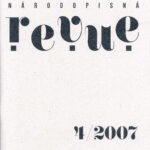Journal of Ethnography 4/2007 outlines the issue of the function and process of communication which have been hitherto infrequent within various ranges of ethnological researches. Alena Křížová deals with the functions of decoration and jewel (Jewel as a Hallmark). Petr Janeček pays his attention to folklore narration and its function in the modern society (Communicating role of folk literature in modern society: urban phantoms of the World War II), Marta Šrámková specifies the contemporary trends of folklore researches from that standpoint (New research field of folkloristics – media communication). In her essay, Martina Vyziblová deals with the communication in relation to ethnic minorities (Work with Romany children or more than just remedial classes) and Eva Večerková gets down to that issue based on traditional material (Christmas Eve “Driving the Sheep to Bethlehem” in South-Western Moravia).
The essay Pilgrimage to St. Antonius (Impressions of a contemporary pilgrim) by Blanka Petráková specifies the changes of tradition. Social Chronicle remembers the anniversaries of the ethnographer Věra Kovářů (born 1932), the literary folklorist Bohuslav Beneš (born 1927) and the enthnographic worker Marie Pachtová (born 1932); it publishes also the obituary notices for Zdeněk Lukáš (1928 – 2007), composer, and Jana Rychtová (1946 – 2007), a personality of folklore movement. In other regular columns, the reports of exhibitions, festivals, concerts, professional branch activity and the reviews of new book editions are published.
Jewel as a Hallmark
The title of the contribution Jewel as a Hallmark glosses the thesis by Peter Bogatyrev called Folk Costume as a Hallmark because it utilizes the identical method of functional structuralism, which is applied on various forms of human body’s decoration and on various appearances of a jewel. This is what expresses the fact that – in common with the clothing – the decoration and jewel present a mean of non-verbal communication. Similarly, the individual functions of decoration and jewels are determined: 1. practical, 2. magic, 3. family and 4. social one, 5. function of distinguishing the ethnical groups, professional and amateur associations and 6. erotic and aesthetic functions that run through the previous categories simultaneously.
Communicating role of folk literature in modern society: urban phantoms of the World War II
The author analyzes the dissemination and social function of rumours about so-called urban phantoms – fictive demoniac beings that were typical for folk literature during the World War II. The rumours about spirits, such as Czech Pérák (Spring Man) and Žiletkář, Slovak Fosforák, American Mad Gasser of Mattoon and Black Flash and Italian Pippo spread at the end of the war and were closely connected with the social tensions of that time. Those war phantoms have their basic features, like expressive realistic anthropomorphic and technological nature and weak continuation of traditional folklore expression. After the non-standard war situation had terminated, the most rumours ceased to exist very quickly; some of them have survived in popular culture and media until now.
New research field of folkloristics – media communication
The communication in folkloristics is understood as handing over of experience that forms a part of social standards, cultural consciousness and folk tradition. Media communication cannot substitute the way of handing over the folklore matters and it does not work with the categories narrative act, life of folklore, narrator and listener, narrative opportunity. Communicating by means of media is not a narrative act; it does not create any tradition and handed-down repertoire. Media communication and folkloristics are two separate systems; their common feature is “handing over of communicating”. Media communication is a feature of technologized society. It determines the rise of non-traditional forms, genres and matters, which are spread by media, within young generation. In the conclusion, the contribution brings some examples of Christmas greetings, freely referring to folk forms. The task of folkloristics is to study the relation to the media communication theories.
Work with Romany children or more than just remedial classes
The text is focused on the education as one of the ways, how to improve the living conditions of the Romany minority significantly. The objective of the text is to point out the necessity of the active participation of the Czech majority in the improvement of Roma’s education and to draw the attention to some specific matters that have to be taken into account with this work. The author proceeds from her practical experience with remedial classes for the Romany children, which are held in the Museum of Romany Culture in Brno for the third year. She makes the readers familiar with the advantages of individual approach applied at the remedial classes; she draws attention to the necessity to enter into open communication among three parties: the family, the school and the tutor giving remedial classes, which is crucial for the remedial classes to be successful. She is taken aback by the problems of language disadvantaging the Romany children, by the entering into relations with a Romany family and the necessity of timely help, which should function as a precaution of the Romany children’s failure at school.
Christmas Eve “Driving the Sheep to Bethlehem” in South-Western Moravia
The author deals with the Christmas habit called “sheep of Bethlehem, driving the sheep to Bethlehem”. She completes the literature reports with the archive and terrain researches. She records the life of the habit, which has survived until now in some places, on the map. She meets with the highest frequency in the region whose centre is the town of Jemnice. The ceremony procession with the local shepherd and children playing sheep happened at Christmas Eve. The shepherd cracked a whip and played the ox horn, the children imitated the sheep with voices and ringing the cowbells. Later on, some new elements were adjoined to the procession of the “shepherd” and his “sheep”, mainly the Christmas tree and the musicians playing famous Christmas carols.



